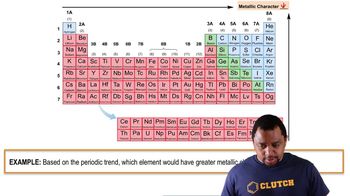Here are the essential concepts you must grasp in order to answer the question correctly.
Metallic Character
Metallic character refers to the tendency of an element to lose electrons and form positive ions, which is a characteristic of metals. Elements with high metallic character are typically good conductors of heat and electricity, have high malleability and ductility, and tend to have lower ionization energies. As you move down a group in the periodic table, metallic character increases, while it decreases across a period from left to right.
Recommended video:
Metallic Character Example
Ionization Energy
Ionization energy is the energy required to remove an electron from an atom in its gaseous state. It is a key factor in determining an element's reactivity and metallic character. Generally, elements with lower ionization energies are more metallic, as they can more easily lose electrons. The statement indicates that element X has a higher ionization energy than element Y, suggesting that Y may have greater metallic character.
Recommended video:
Conductivity and Semiconductors
Conductivity refers to the ability of a material to conduct electricity, which is a property of metals and some non-metals known as semiconductors. Metals are excellent conductors due to their free-moving electrons, while semiconductors have intermediate conductivity that can be altered by temperature or impurities. The distinction between a good conductor and a semiconductor is crucial in determining the properties of elements X and Y in the context of their metallic character.
Recommended video:
Extensive Property Example




